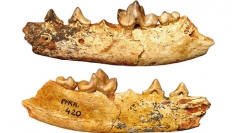

 Geodiversitas
35 (4) - Pages 787-814
Geodiversitas
35 (4) - Pages 787-814Many karstic fissure fillings from the Quercy (France) constitute fossil bearing localities which give an exceptional open laboratory for the study of evolution of vertebrates and especially mammals from the Eocene to the Early Miocene. A couple of localities from the Late Oligocene (MP 28 = 24.9-24.5 Ma) have yielded, among several taxa, the best sample ever found of a hemicyonine ursid. This sample corresponds to a new species and allows a reappraisal of several other species belonging to lineages attributed to a new tribe (Cephalogalini n. tr.). The latter occupied in Europe along the Oligocene and the lower Miocene some canid-like ecological niches. This tribe was replaced at the end of the Lower Miocene by the Hemicyonini, another tribe of Hemicyoninae (Ursidae).
Hemicyoninae, evolution, biometry, ecology, Late Oligocene, Quercy, new tribe, new genera, new species